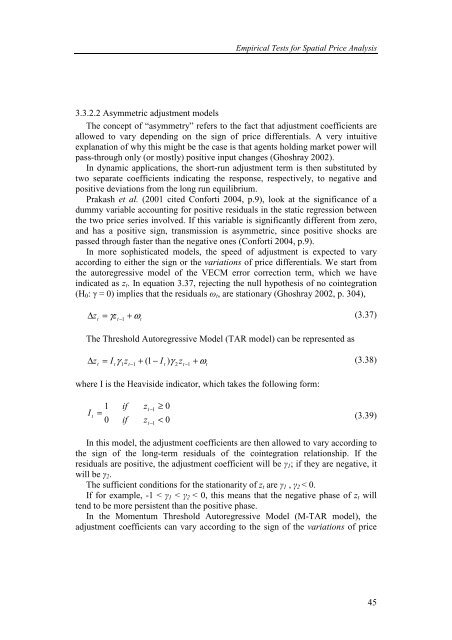TESTING INTERNATIONAL PRICE TRANSMISSION UNDER ...
TESTING INTERNATIONAL PRICE TRANSMISSION UNDER ...
TESTING INTERNATIONAL PRICE TRANSMISSION UNDER ...
You also want an ePaper? Increase the reach of your titles
YUMPU automatically turns print PDFs into web optimized ePapers that Google loves.
Empirical Tests for Spatial Price Analysis<br />
3.3.2.2 Asymmetric adjustment models<br />
The concept of “asymmetry” refers to the fact that adjustment coefficients are<br />
allowed to vary depending on the sign of price differentials. A very intuitive<br />
explanation of why this might be the case is that agents holding market power will<br />
pass-through only (or mostly) positive input changes (Ghoshray 2002).<br />
In dynamic applications, the short-run adjustment term is then substituted by<br />
two separate coefficients indicating the response, respectively, to negative and<br />
positive deviations from the long run equilibrium.<br />
Prakash et al. (2001 cited Conforti 2004, p.9), look at the significance of a<br />
dummy variable accounting for positive residuals in the static regression between<br />
the two price series involved. If this variable is significantly different from zero,<br />
and has a positive sign, transmission is asymmetric, since positive shocks are<br />
passed through faster than the negative ones (Conforti 2004, p.9).<br />
In more sophisticated models, the speed of adjustment is expected to vary<br />
according to either the sign or the variations of price differentials. We start from<br />
the autoregressive model of the VECM error correction term, which we have<br />
indicated as zt. In equation 3.37, rejecting the null hypothesis of no cointegration<br />
(H0: γ = 0) implies that the residuals ωt, are stationary (Ghoshray 2002, p. 304),<br />
Δz = γ z −1 + ω<br />
(3.37)<br />
t<br />
t<br />
t<br />
The Threshold Autoregressive Model (TAR model) can be represented as<br />
Δ t = I t 1 zt<br />
−1 + 1−<br />
I t ) γ 2 zt<br />
−1<br />
z γ ( + ω<br />
(3.38)<br />
where I is the Heaviside indicator, which takes the following form:<br />
I<br />
t<br />
1<br />
=<br />
0<br />
if<br />
if<br />
z<br />
z<br />
t−1<br />
t−1<br />
≥ 0<br />
< 0<br />
t<br />
(3.39)<br />
In this model, the adjustment coefficients are then allowed to vary according to<br />
the sign of the long-term residuals of the cointegration relationship. If the<br />
residuals are positive, the adjustment coefficient will be γ1; if they are negative, it<br />
will be γ2.<br />
The sufficient conditions for the stationarity of zt are γ1 , γ2 < 0.<br />
If for example, -1 < γ1 < γ2 < 0, this means that the negative phase of zt will<br />
tend to be more persistent than the positive phase.<br />
In the Momentum Threshold Autoregressive Model (M-TAR model), the<br />
adjustment coefficients can vary according to the sign of the variations of price<br />
45
















